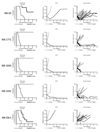Initial testing of the replication competent Seneca Valley virus (NTX-010) by the pediatric preclinical testing program
- PMID: 20582972
- PMCID: PMC3003870
- DOI: 10.1002/pbc.22535
Initial testing of the replication competent Seneca Valley virus (NTX-010) by the pediatric preclinical testing program
Erratum in
- Pediatr Blood Cancer. 2012 Apr;58(4):652
Abstract
Background: Seneca Valley virus (NTX-010) is a non-recombinant, replication competent RNA virus that is undergoing phase 1 clinical trials in adults for tumors with neuroendocrine characteristics. Here we have evaluated the antitumor activity of NTX-010 administered systemically.
Procedures: In vitro NTX-010 was tested against 23 cell lines exposed for 96 hr at 1 x 10(-4) to 10(4) viral particles (vp)/cell. In vivo NTX-010 was administered intravenously once at 3 x 10(12) vp/kg. Three measures of antitumor activity were used: (1) an objective response measure modeled after the clinical setting; (2) a treated to control (T/C) tumor volume measure; and (3) a time to event (fourfold increase in tumor volume for solid tumor models), measure based on the median event-free survival (EFS) of treated and control animals for each xenograft.
Results: In vitro NTX-010 demonstrated a marked cytotoxic effect in a subset of the cell lines from the neuroblastoma, Ewing sarcoma, and rhabdomyosarcoma panels. In vivo the most consistent activity was observed for the rhabdomyosarcoma and the neuroblastoma panels, with all four of the alveolar rhabdomyosarcoma xenografts and four of five neuroblastoma xenografts achieving CR or maintained CR. Objective responses were also observed in the rhabdoid tumor, Wilms tumor, and glioblastoma panels.
Conclusions: NTX-010 demonstrated a high level of activity both in vitro and in vivo. Further analysis of existing testing and molecular characterization data may help define the biological characteristics of cancer cells that are associated with response to NTX-010.
(c) 2010 Wiley-Liss, Inc.
Conflict of interest statement
Figures





Similar articles
-
Phase I trial of Seneca Valley Virus (NTX-010) in children with relapsed/refractory solid tumors: a report of the Children's Oncology Group.Pediatr Blood Cancer. 2015 May;62(5):743-50. doi: 10.1002/pbc.25269. Epub 2014 Oct 12. Pediatr Blood Cancer. 2015. PMID: 25307519 Free PMC article. Clinical Trial.
-
Initial testing of the aurora kinase A inhibitor MLN8237 by the Pediatric Preclinical Testing Program (PPTP).Pediatr Blood Cancer. 2010 Jul 15;55(1):26-34. doi: 10.1002/pbc.22430. Pediatr Blood Cancer. 2010. PMID: 20108338 Free PMC article.
-
Initial testing of cisplatin by the pediatric preclinical testing program.Pediatr Blood Cancer. 2008 May;50(5):992-1000. doi: 10.1002/pbc.21263. Pediatr Blood Cancer. 2008. PMID: 17554786 Clinical Trial.
-
Initial testing of topotecan by the pediatric preclinical testing program.Pediatr Blood Cancer. 2010 May;54(5):707-15. doi: 10.1002/pbc.22352. Pediatr Blood Cancer. 2010. PMID: 20017204 Free PMC article.
-
[Cytopathology of malignant blastematous tumors].Ann Pathol. 2004 Dec;24(6):568-73. doi: 10.1016/s0242-6498(04)94019-9. Ann Pathol. 2004. PMID: 15785403 Review. French.
Cited by
-
Pediatric Cancer Immunotherapy: Opportunities and Challenges.Paediatr Drugs. 2018 Oct;20(5):395-408. doi: 10.1007/s40272-018-0297-x. Paediatr Drugs. 2018. PMID: 29948928 Free PMC article. Review.
-
Effect of Repeat Dosing of Engineered Oncolytic Herpes Simplex Virus on Preclinical Models of Rhabdomyosarcoma.Transl Oncol. 2016 Oct;9(5):419-430. doi: 10.1016/j.tranon.2016.07.008. Transl Oncol. 2016. PMID: 27751346 Free PMC article.
-
Seneca Valley Virus 3Cpro Substrate Optimization Yields Efficient Substrates for Use in Peptide-Prodrug Therapy.PLoS One. 2015 Jun 12;10(6):e0129103. doi: 10.1371/journal.pone.0129103. eCollection 2015. PLoS One. 2015. PMID: 26069962 Free PMC article.
-
Tolerance of Senecavirus A to Mutations in Its Kissing-Loop or Pseudoknot Structure Computationally Predicted in 3' Untranslated Region.Front Microbiol. 2022 May 30;13:889480. doi: 10.3389/fmicb.2022.889480. eCollection 2022. Front Microbiol. 2022. PMID: 35707163 Free PMC article.
-
Pharmacologic management of high-risk neuroblastoma in children.Paediatr Drugs. 2011 Aug 1;13(4):245-55. doi: 10.2165/11591630-000000000-00000. Paediatr Drugs. 2011. PMID: 21692548 Free PMC article. Review.
References
-
- Alemany R, Balague C, Curiel DT. Replicative adenoviruses for cancer therapy. Nat Biotechnol. 2000;18(7):723–727. - PubMed
-
- O'Shea CC. Viruses - seeking and destroying the tumor program. Oncogene. 2005;24(52):7640–7655. - PubMed
-
- Russell SJ. RNA viruses as virotherapy agents. Cancer Gene Ther. 2002;9(12):961–966. - PubMed
-
- Alemany R. Cancer selective adenoviruses. Molecular aspects of medicine. 2007;28(1):42–58. - PubMed
Publication types
MeSH terms
Grants and funding
LinkOut - more resources
Full Text Sources
Other Literature Sources

